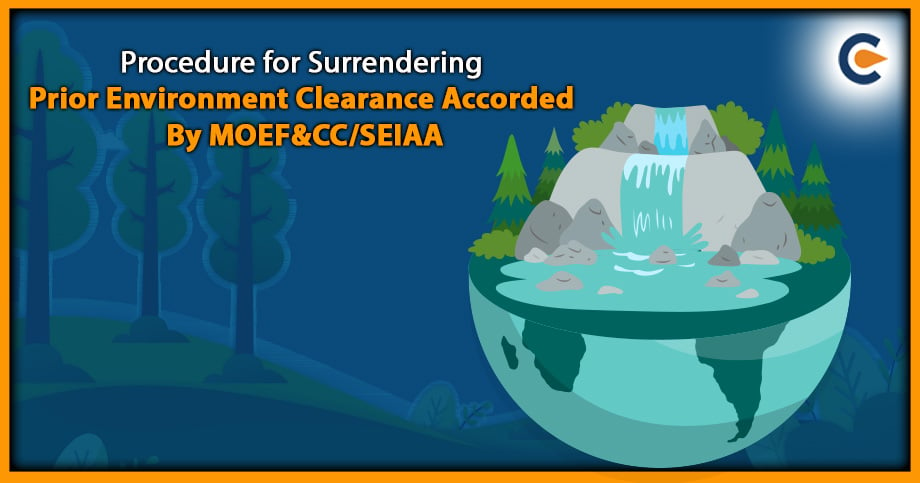Environmental Clearance (EC) for the certain project has been made compulsory by the MoEF, i.e. Ministry of Environment & Forests, via its notification released under the norms of Environment (Protection) Act, 1986. In view of prolonged experience in the Environmental Clearance process as well as the demands of concerned stakeholders, the MoEF rolled out a revised notification on the EC process in Sep 2006 and changed it in Dec 2009. It was considered imperative by MoEF to make accessible EIA direction manuals for each of the development sectors. This write-up elaborates the process of Environmental clearance in detail.
Environmental Impact Notification Released on September 2006
- Environmental Impact Notification S.O.1533 (E), released on Sep 2006 under Environment (Protection) Act 1986 has clarified that the scheduled development projects should mandatorily obtain environmental clearance.
- The said notification has categorized projects under two major categories – ‘A’ & ‘B’. Category A projects (including modernization and expansion of prevailing projects) require clearance from MoEF and for category B from SEIAA, i.e. Environmental Impact Assessment Authority, formed by GOI.
Process of Environmental Clearance in India
The section below illustrates the process of Environmental Clearance in India
Step 1: Site identification and selection
The project proponent pinpoints the plant’s location after adhering to existing underlying guidelines. If the project site fails to ensure conformity with the siting guideline, the proponent must lookout for an alternative site for the project.
Step 2: Category evaluation
The project proponent then evaluates whether the proposed project falls under the ambit of environmental Clearance or not. If it falls under the notification schedule, the proponent performs an EIA study either directly or via a third party. If the project falls under category B, it needs to be sanctioned via the state government for Clearance. For this purpose, the state government categorises such projects into B1 and B2 projects. The preparation of the EIA report is not required for the B2 project.
Step 3: Submission of EIA report and Assessment by SPCB
After preparing the EIA report, the investor furnishes the same to the respective State Pollution Control Board and State-based Forest Department (if the location is present nearby/within the forestland). The SPCB examines and assesses the quality and quality of effluent or pollutants likely to generate the project. The authority also evaluates the efficacy of the control measures proposed to fulfil the underlying norms. If the SPCB does not find any loophole in this context, it shall grant its approval in the form of a No-objection certificate.
Step 4: Public hearing
The public hearing is a vital step in securing environmental Clearance. This facilitates a legal space for habitant of an area to put up their concern before the government regarding the credibility or viability of the project.
The public hearing process is performed before the issuance of the NOC described above. The District Collector is the person who chaired such a committee. Other key members of the committee include the official from the SPCB, district development body, Department of Environment and Forest, Gram Panchayat representative and senior citizen of the district, etc. The hearing committee evaluates the suggestions/objections submitted by the general public. After adding certain clauses, it is passed on to the subsequent stage of approval (Ministry of Forest and Environment).
Step 5: Application submission to MoEF
The project proponent furnishes the duly filed application for environmental Clearance with the Ministry of Forest and Environment if it falls under the category of Project A or the state government if it comes under project B category. The application form is accompanied by standard documents such as the EIA report, EMP, NOC, and public hearing details.
Step 6: Environmental appraisal
The documents furnished are first examined by a multi-disciplinary the Ministry of Environment and Forests staff. The said staff may also conduct on-site inspections, contact investors, and consult with experts on some issues if required.
After this, the proposals are forwarded to specially constituted committees of professionals whose composition is mentioned in the EIA Notification.
Such committees are called Environmental Appraisal Committees, which has been set up for each sector such as Industries, River Valley, and Mining etc. And these committees meet consistently to evaluate the proposals received in the Ministry. In the case of certain projects, which have attracted significant public attention, the committee may also arrange for public hearings to public intervention in developmental decisions.
Proclamations for these public hearings shall be made thirty days before via newspapers. Based on the exercise cited above, the Appraisal Committees put forward their recommendations for approval or rejection of particular projects.
The Committees’ recommendations are then undergone evaluation conducted by the Ministry of Environment and Forests.
Step 7: Issuance of Clearance or rejection letter
When a project seeks mandatory environmental Clearance and consent under Forest (Conservation) Act, 1980[1], the proposals for either of them are required to be facilitated simultaneously to the respective divisions of the Ministry.
Though individual letters may be issued, the processing is undertaken concurrently for clearance/rejection. If the project does not have any requirement for forest land diversion, the case is processed for environmental Clearance only.
Once all the mandatory documentation and data from the concerned authorities are received, and public hearings have been successfully held, assessment and evaluation about the project from the environment viewpoint are completed within 90 days. The Ministry’s decision shall be conveyed within thirty days after that.
The Clearance issued shall remain valid for five years from the commencement of the project’s operation.
Eligibility Criteria for Environmental Clearance
Industrial projects from the given notified ecological fragile/sensitive areas shall require Environmental Clearance regardless of the type of project.
- Religious and historical places
- Scenic areas
- Archaeological monuments
- Beach resorts
- Hill resorts
- Coastal areas rich in corals, mangroves, breeding grounds of specific species
- Estuaries
- Biosphere reserves
- Gulf areas
- National parks and sanctuaries
- Seismic zones
- National lakes and swamps
- Tribal settlements
- Areas of scientific and geological interest
- Defence installations, especially those of security importance & sensitivity to pollution
- Airports
- Border areas (international)
Significance of Public hearing in Environmental Clearance
- Public involvement plays a vital role in a successful EIA process. It facilitated a chance for those affected by the project to put forward their concerns on the social and environmental impact of the proposal and ensured transparency within the environmental clearance system.
- Almost all EIA system has underpinned a provision relating to public involvement. It could happen in the form of public participation or public consultation.
- Most EIA processes are conducted via public consultation. Public consultation refers to a process by which the concerns of habitants relating to negative impacts are taken into account in the EIA study.
- This concept was come to effect in 1997 in the form of ‘public hearing’. Since then, this process has been undertaken as a vital environmental clearance step for most projects.
- The public consultation process underpins an unprejudiced and transparent decision-making process resulting in optimal environmental outcomes.
- The type of consultation, whom to take advice during EIA undertakings, when and how to do so and who should perform it differ considerably project-wise. This depends on the requirement of the project. But, it is a vital element for all project types. Public consultations mitigate the local community’s concerns and minimise invalid detail in the EIA report.
- Ideally, public consultation must commence when the notion of the project is realised and prevail throughout the EIA phase.
- The five fundamental stages of public involvement in the EIA process are examining, scoping, impact assessment and mitigation, verifying EIA quality, and implementation and follow up.
- In India, the public involvement role in the environment clearance process has yet to gain importance within the industrial regime. This is why its scope is quite limited for the time being.
- Public consultation comes into play post-preparation of the EIA report and when the proponent is ready to present it to the review committee. This implies that the EIA study cannot take public concerns and issues into account.
- Even if the community’s members intimate particular concerns during the public hearing process, they have no surety if it actually gets attended in the last EIA report as it is inaccessible to them.
- There are various pain points in the public hearing process. For the time being, it is merely considered as a procedure instead of a participatory forum. The new notification proposes fixing such issues and rendering an edge to the entire public hearing process.
- However, the said notification does not ensure the large scope of improvement. It merely added a new provision that provides for the omission of the public hearing process if the situation is not favourable for conducting the hearing as realised by the local authority.
- This provision can be subject to mis-utilization, thereby limiting the scope of public participation. Several scenarios in the past have witnessed the failure of the public hearing process in ensuring public involvement. Several measures have been formulated to isolate the public from the public hearing process, such as limited notice circulation, politics, etc.
Conclusion
Environmental Clearance seeks to curb industries and projects that supposedly hamper the environment and living species in one way or another. It serves as a legal consent for industries that are unfriendly to environment. It has been made mandatory under Environment Protection Act, 1986.
Read our Article:Imposition of Environmental Compensation under Plastic Waste Management Rules











